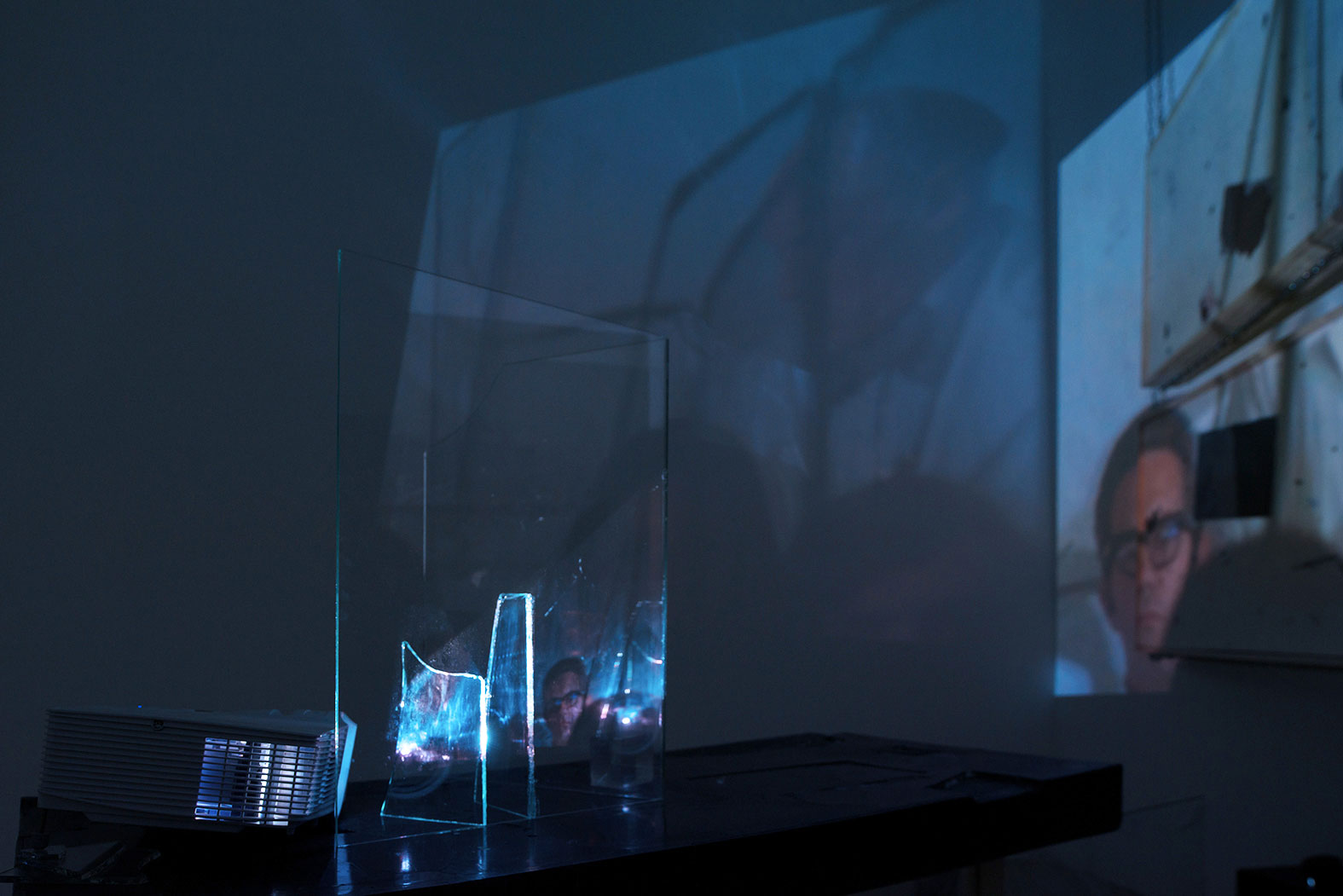Group show, 2015
at Galerie Valeria Cetraro, Paris (Fr)
Text by Ingrid Luquet-Gad
Featured work :
at Galerie Valeria Cetraro, Paris (Fr)
Text by Ingrid Luquet-Gad
Featured work :
Skinny Dip Uncensory single-channel video installation 2015


︎Skinny Dip Unsensory single-channel video installation 2015
LED dispay debris, wax, glass, wood, chains, mirror, resin. Variable dimensions.
Video, color, stereo sound, 20'
stereo sound, 12’
Laura Gozlan treats filmic images as if they were a post- human body to be dissected and then reassembled. Her videos mix B-movie scenes, archival scientific footage and utopian science fiction in neo-expanded cinema settings, bringing to light the archetypical unconscious that resurfaces after the collapse of the dream of scientific and technological mastery.
Like wax, a material Laura Gozlan is particularly fond of, images are malleable and can be made to eternally oscillate between dematerialization and rematerialization. A graduate of the Arts Décoratifs and the Fresnoy national art schools, her first stop-motion films gradually evolved into environments incorporating videos made with found images. The reasons were multiple: accident, lack of resources, a creative process unfolding through trial and error, as well as an unspoken affinity for the occult sciences and alchemy that would mark her work, from the start concerned with the theme of changing states of matter. This affinity has allowed her to bring to light, just under smooth digital surfaces, a handful of archetypes that haunt her movies.
Her most recent work, Skinny Dip Unsensory, presented this winter as part of the collective exhibition Au-dela de l’image (ll) at Galerie Valeria Cetraro in Paris, took its point of departure from the writings of the neuroscientist John Cunningham Lilly. A notorious figure in the 1960 California counterculture scene and pioneer in the field of the study of consciousness, this friend of Allen Ginsberg and Timothy Leary developed protocols for experiments with sensory isolation chambers and interspecies communication. Gozlan used footage from six or seven films, from science documentaries to giallo Italian B-movies, to produce a twenty-minute loop. Later, she added a sound track. When projected, the images are no longer flat but refracted on sheets of glass, reflective plasticand crystals. She calls this part of the process defragmentation. Then she adds projections that encircle the viewer, who is caught between two pieces of molded wax hanging from the ceiling. Caught up in this mechanism that is something between the canonical cinematic black box and experiments with hallucinations triggered by sensory deprivation, viewers meld with the enveloping images and at the same time are forced to distance themselves from them so as to reconstitute the plot of a narrative in which the temporality, linkages between things and events, and the medium itself are no longer familiar.
Immediately, one thinks of expanded cinema and the Exploding Plastic Inevitable, the series of multimedia performances Andy Warhol organized in 1966-67, where Jonas Mekas projected his film of the same name onto the bodies of the performers. But at a closer look, Gozlan’s installations are different. In her topology made of splinters, ridges, hollows and recesses, the individual finds themself inside the image as if it were a new milieu*, reflecting a different way of being in the world—and being in it as its image. Further, these projections are no longer cast onto the human body or even in front of it; rather, they surround and infiltrate it, digitally imparting a new sensory orientation that realizes Deleuze’s prediction of a body without organs. With the simultaneity of the digital, a new eye-ear continuum is born. This is no longer, as expanded cinema was for Mekas, an aesthetic celebration of reality, because all of reality is contained in the image. But it is not a flattening of things either. Gozlan lets us see that just as reality has entirely gone inside the image, so have its repressed depths.
Gozlan disinters the mythological unconscious of our modern society, always ready to re-emerge whenever cracks appear in our technico-scientific certitudes. Filtering through the moiré Screen-image, we glimpse not only violence and sex but also proto-scientific ancestral fantasies, themes that become obvious once we distance ourselves from the compulsive attraction of the calming lapping sound of the digital tide. The decentering takes place through a logic similar to the heuristic model of the speculative realist genre of science fiction, which deposits the need for a no longer human-centric reconception of the world. " The video makes a mash-up of childish and almost magical desires. When you realize that films can be cut apart and then reassembled, you can bring together characters that have never shared the same space," she explains. Here we find ourselves entering the heart of Noir romanticism, with the shadow of Frankenstein, that modern Prometheus, falling on the image dissecting table. Gozlan has imagined the meeting of Philip K. Dick and Stephen Hawking (Translation par les modèles 2012). More basically, the medium of filmed images itself can be manipulated to bring back fetishes forgotten by modernity, suddenly making it possible to actualize the mad projects of the proto-sciences —mental telepathy, time travel, resurrection. Of course, thinking the hyper-present implies a critique of digital reason, as recently undertaken by Eric Sadin*. But it also means reconnecting with our unconscious impulses and mythical projections that inevitably invest technology and the images it generates. Gozlan takes us all the way there.
* According to the concept of milieu technique that simultaneously designates what is around individuals and between them, the point where the medium and the environment meet, as theorized by André Leroi-Gourhan and Georges Friedmann.
* Eric Sadin, La Vie algorithmique : critique de la raison numérique, L’échappée 2015.
Ingrid Luquet-Gad



